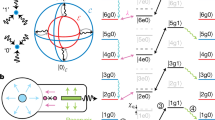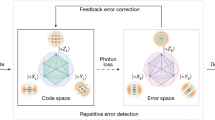Abstract
A fundamental requirement for enabling fault-tolerant quantum information processing is an efficient quantum error-correcting code that robustly protects the involved fragile quantum states from their environment1,2,3,4,5,6,7,8,9,10. Just as classical error-correcting codes are indispensible in today's information technologies, it is believed that quantum error-correcting code will play a similarly crucial role in tomorrow's quantum information systems. Here, we report on the experimental demonstration of a quantum erasure-correcting code that overcomes the devastating effect of photon losses. Our quantum code is based on linear optics, and it protects a four-mode entangled mesoscopic state of light against erasures. We investigate two approaches for circumventing in-line losses, and demonstrate that both approaches exhibit transmission fidelities beyond what is possible by classical means. Because in-line attenuation is generally the strongest limitation to quantum communication, such an erasure-correcting code provides a new tool for establishing quantum optical coherence over longer distances.
This is a preview of subscription content, access via your institution
Access options
Subscribe to this journal
Receive 12 print issues and online access
$209.00 per year
only $17.42 per issue
Buy this article
- Purchase on Springer Link
- Instant access to full article PDF
Prices may be subject to local taxes which are calculated during checkout




Similar content being viewed by others
References
Nielsen, M. A. & Chuang, I. L. Quantum Computation and Quantum Information (Cambridge Univ. Press, 2000).
Shor, P. W. Scheme for reducing decoherence in quantum computer memory. Phys. Rev. A 52, R2493–R2496 (1995).
Steane, A. M. Error correcting codes in quantum theory. Phys. Rev. Lett. 77, 793–797 (1996).
Calderbank, A. R. & Shor, P. W. Good quantum error-correcting codes exist. Phys. Rev. A. 54, 1098–1105 (1996).
Laflamme, R., Miquel, C., Paz, J. P. & Zurek, W. H. Perfect quantum error correcting code. Phys. Rev. Lett. 77, 198–201 (1996).
Bennett, C. H., DiVincenzo, D. P., Smolin, J. A. & Wootters, W. K. Mixed-state entanglement and quantum error correction. Phys. Rev. A 54, 3824–3851 (1996).
Grassl, M., Beth, Th. & Pellizzari, T. Codes for the quantum erasure channel. Phys. Rev. A 56, 33–38 (1997).
Braunstein, S. Error correction for continuous quantum variables. Phys. Rev. Lett. 80, 4084–4087 (1998).
Lloyd, S. & Slotine, J.-J. E. Analog quantum error correction. Phys. Rev. Lett. 80, 4088–4091 (1998).
Braunstein, S. L. Quantum error correction for communication with linear optics. Nature 394, 47–49 (1998).
Duan, L. M., Lukin, M. D., Cirac, J. I. & Zoller, P. Long-distance quantum communication with atomic ensembles and linear optics. Nature 414, 413–418 (2001).
Yuan, Z.-S. et al. Experimental demonstration of a BDCZ quantum repeater node. Nature 454, 1098–1101 (2008).
Knill, E. Quantum computing with realistically noisy devices. Nature 434, 39–44 (2005).
Wilde, M. M., Krovi, H. & Brun, T. A. Entanglement-assisted quantum error correction with linear optics. Phys. Rev. A 76, 052308 (2007).
Niset, J., Andersen, U. L. & Cerf, N. J. Experimentally feasible quantum erasure-correcting code for continuous variables. Phys. Rev. Lett. 101, 130503 (2008).
Cory, D. G. et al. Experimental quantum error correction. Phys. Rev. Lett. 81, 2152–2155 (1998).
Chiaverini, J. et al. Realization of quantum error correction. Nature 432, 602–605 (2004).
Pittmann, T. B., Jacobs, B. C. & Franson, J. D. Demonstration of quantum error correction using linear optics. Phys. Rev. A 71, 052332 (2005).
Aoki, T. et al. Quantum error correction beyond qubits, Nature Phys. 5, 541–546 (2009).
Wittmann, C. et al. Quantum filtering of optical coherent states. Phys. Rev. A 78, 032315 (2008).
Majumdar, A. K. & Ricklin, J. C. Free-Space Laser Communications (Springer, 2008).
Elser, D. et al. Feasibility of free space quantum key distribution with coherent polarization states, N. J. Phys. 11, 045014 (2009).
Niset, J., Fiurasek, J. & Cerf, N. J. No-go theorem for Gaussian quantum error correction. Phys. Rev. Lett. 102, 120501 (2009).
Lance, A. M. et al. Tripartite quantum state sharing. Phys. Rev. Lett. 92, 177903 (2004).
Niset, J. et al. Superiority of entangled measurements over all local strategies for the estimation of product coherent states. Phys. Rev. Lett. 98, 260404 (2007).
Van Loock, P. et al. Broadband teleportation. Phys. Rev. A 62, 022309 (2000).
Acknowledgements
This work was supported by the Future and Emerging Technologies programme of the European Commission under the FP7 FET-Open grant no. 212008 (COMPAS), by the Danish Agency for Science Technology and Innovation under grant no. 274-07-0509, by the Deutsche Forschungsgesellschaft, and by the Interuniversity Attraction Poles program of the Belgian Science Policy Office under grant IAP P6-10 (photonics@be).
Author information
Authors and Affiliations
Contributions
M.L. and M.S. performed the experiments. J.N. and N.J.C. performed the theoretical calculations. M.L., M.S. and A.H. performed the data analysis. M.L., N.J.C. and U.L.A. wrote the manuscript. M.L., M.S., U.L.A. and G.L. performed the project planing. All authors discussed the results and implications and commented on the manuscript at all stages. Correspondence and requests for additional materials should be addressed to M.L. or U.L.A.
Corresponding authors
Ethics declarations
Competing interests
The authors declare no competing financial interests.
Rights and permissions
About this article
Cite this article
Lassen, M., Sabuncu, M., Huck, A. et al. Quantum optical coherence can survive photon losses using a continuous-variable quantum erasure-correcting code. Nature Photon 4, 700–705 (2010). https://doi.org/10.1038/nphoton.2010.168
Received:
Accepted:
Published:
Issue Date:
DOI: https://doi.org/10.1038/nphoton.2010.168
This article is cited by
-
Slowing quantum decoherence of oscillators by hybrid processing
npj Quantum Information (2022)
-
Nonclassical Features of Intra-Cavity and Transmitted Fields in a Coherently-Pumped Correlated-Emission Laser with Injected Thermal Light†
Journal of Russian Laser Research (2022)
-
Five-wave-packet quantum error correction based on continuous-variable cluster entanglement
Scientific Reports (2015)



